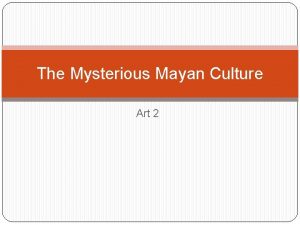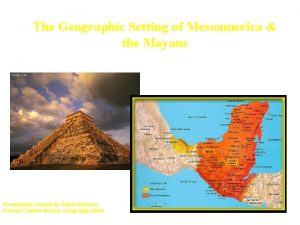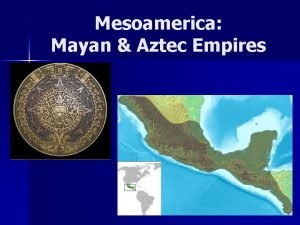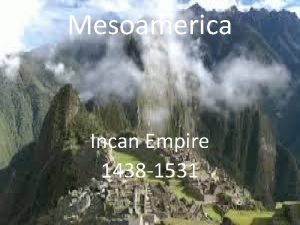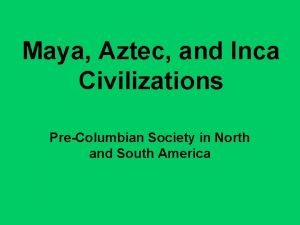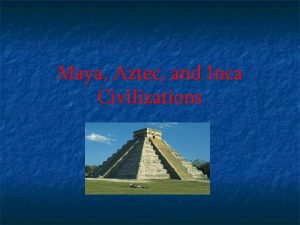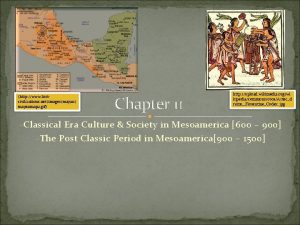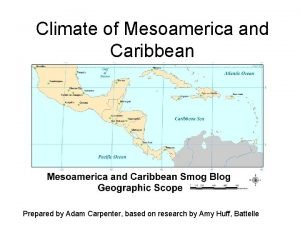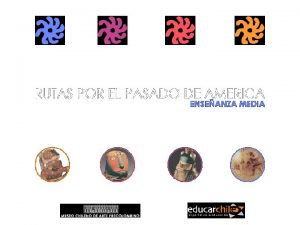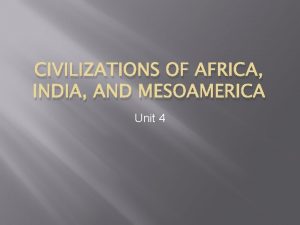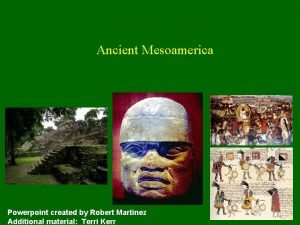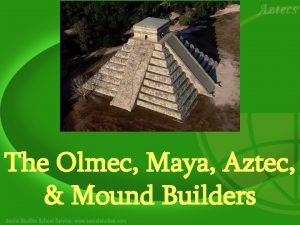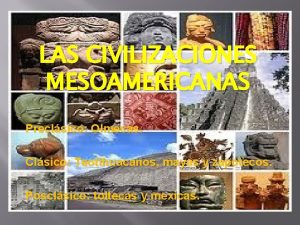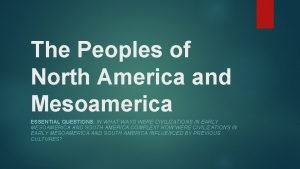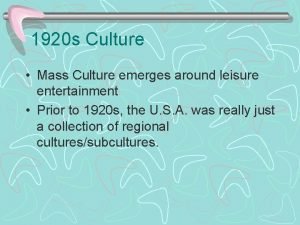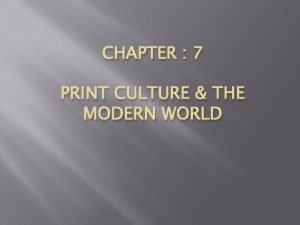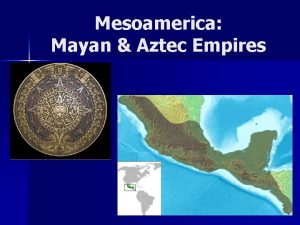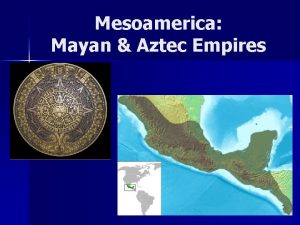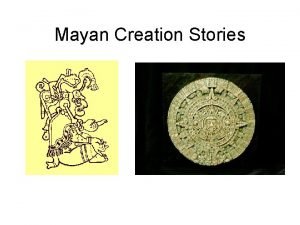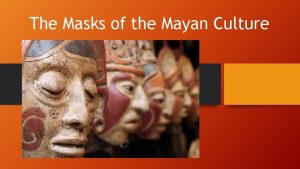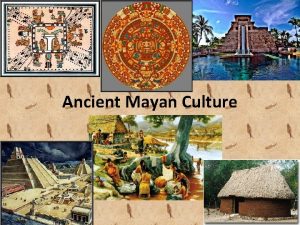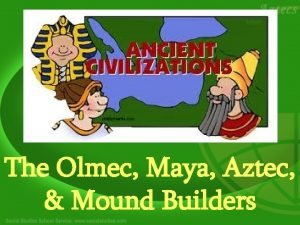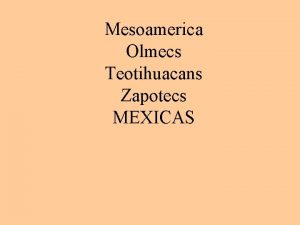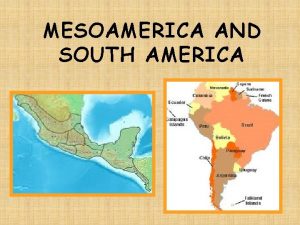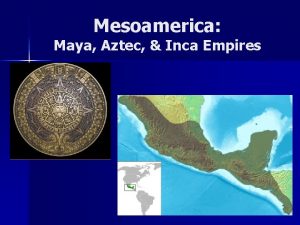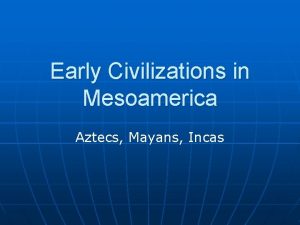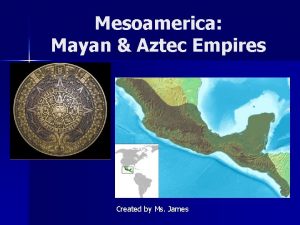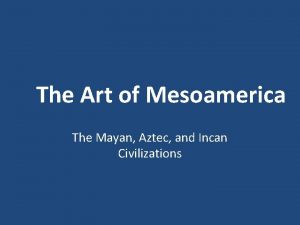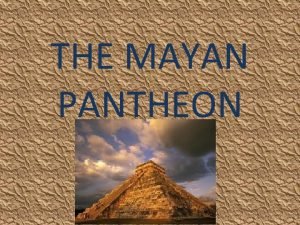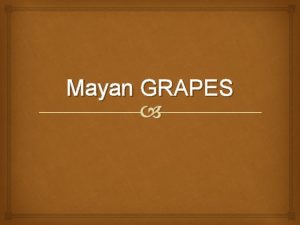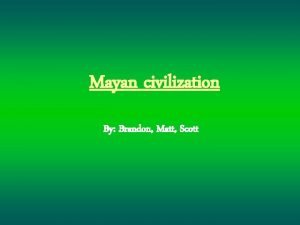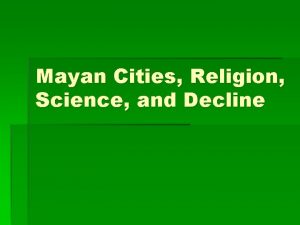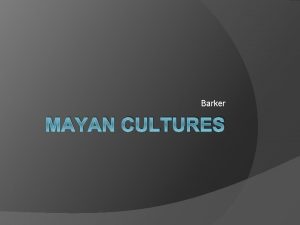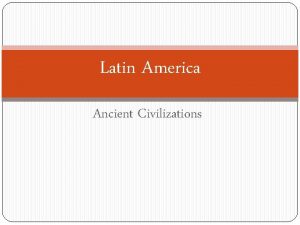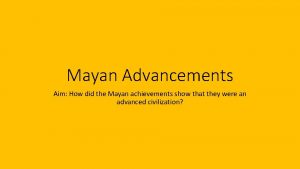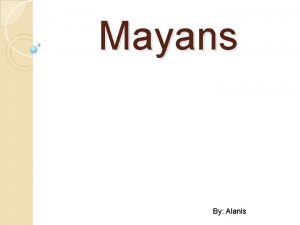Modern Mayan Culture in Mesoamerica Part Two Presentation

















































- Slides: 49

Modern Mayan Culture in Mesoamerica: Part Two Presentation created by Robert Martinez Primary Content Source: Geography Alive!

Two farmers are heading to work in a highland Maya village, but they are heading in different directions. One is heading to his field on the slopes above town, where he will work to provide food for his family as his ancestors have done for hundreds of years.

The other is catching a bus for the lowlands. This farmer works for cash on a modern plantation.

While farming has always been central to the Mayan way of life, changing circumstances and new agricultural methods have altered the way farmers work.

Most Maya are subsistence farmers, growing corn, beans, squash, and other vegetables on small plots called milpas.

Each year these farmers hope to gather enough food at harvest time to feed their families for the next year. The majority of what they harvest will be corn, the Maya’s most important crop.

In fact, corn is considered sacred to the Maya, who call it the “giver of life. ”

Traditionally, Mayan farmers cleared their land using the slash-and-burn method. They cut down the forest and burned the cut trees and shrubs after they dried out.

Then, using simple wooden tools, the farmers dug the ash into the ground to fertilize the soil. Some also mixed in manure and other natural fertilizers to help their crops grow.

Some Maya still follow traditional farming methods, but in many parts of the highlands, much of the land has already been cleared. As a result, slash and burn agriculture is no longer as common as it once was among Mayan farmers.

Many farmers adapted by using chemical fertilizers to enrich the soil. Some Mayan farmers have developed new methods for growing crops in the shade of their own orchards.

Mayan farmers have adapted in other ways. Many spend part of the year working for wages on commercial farms, which now account for most of the land in Guatemala.

This concentration of land on large farms dates back to when the Spanish colonized and took over the best land.

Today about 2 percent of the population still owns 70 percent of the land. Most large landowners raise sugarcane, coffee, cotton, and other crops for export.

Large plantations depend on Mayan farmers who travel to the lowlands to work. These migrant workers spend weeks or even months away from their families.

When they return, they usually have some money saved. But plantation wages are low, and many farm families still struggle to make a living.

It’s market day in Chichicastenago, Guatemala. At 7 A. M. a chilly mist still hangs over the town, but already the plaza is jammed with people.

Most are Maya from the surrounding countryside. They have come to buy and sell food, tools, and other goods. There also may tourists from around the world who have come to experience one of the most famous markets in the Mayan region.

Market day is an important tradition the Mayan highlands. Markets still offer a strong flavor of Mayan culture. They also reflect many changes taking place in the Mayan world.

Mayan markets are held one or two days a week, with Sunday often the most popular choice for market day. A Mayan market typically spreads out from the central plaza into the surrounding streets.

Stalls selling the same type of goods are usually grouped together: fruits and vegetables are found in one area, household goods in another, and so on.

Markets also have food stalls to feed hungry shoppers. Merchants in some stalls offer such services as shoe repair, portrait photography, and money lending.

Highland markets have changed as tourists have come to the highlands to see historic Mayan sites. In Chichicastenango, a large part of the market is devoted to tourist items.

Some popular items are traditional Mayan products, like weavings and wood carvings. Other items, such as purses and baseball caps, are designed just for tourists.

The way merchants conduct trade in Mayan markets has also changed as a result of tourism.

Many years ago, barter was a common way to obtain goods in these markets. For example, a Maya might exchange a basket of vegetables for a certain amount of salt or sugar.

With so many outsiders visiting the markets, merchants today trade mostly with money.

Other recent changes in the Mayan marketplace also reflect modern influences. For instance, at one time merchants did most market trading in Mayan languages.

Now that more people from outside the local community shop at the markets, Spanish has become the common tongue.

In addition, certain goods in highland markets, such as radios and plastic toys, show adaptations to modern life.

On a hillside above Chichicastenago sits the Mayan shrine of Pascual Abaj. The Quiche’ Maya come to this shrine to worship their ancient gods, kneeling before a small, carved altar and burning candles and incense.

They ask the gods to bring a good harvest and to cure the sick. Five hundred years after the Spanish conquest, the Maya still keep their ancient traditions alive.

The ancient Maya worshipped many gods. These gods represented elements of the natural world, such as the sun, rain, and lightning.

For the Maya, everything in the world, even rocks and water, had a spirit.

When the Spanish arrived in the 1500 s, they sought to convert the Maya to Christianity. Spain was a Catholic country, and over time most Maya also became Catholics.

But they also kept their ancient beliefs. In fact, they blended their old beliefs with Catholicism to form a new kind of religion.

The Maya saw little conflict between their old and their new beliefs. They felt that they could worship Catholic saints and still remain faithful to their own gods.

Mayan representations of Catholic saints even took on features of the Mayan gods.

Today religious festivals throughout the Mayan highlands express this blended religion. Easter week and Christmas are major holidays, celebrated by attending Catholic mass and carrying images of the saints through the streets.

The Maya also celebrate these occasions in Mayan fashion. They listen to traditional music played on Mayan instruments and watch traditional dances performed by masked dancers in Mayan costumes.

They also pray to Mayan gods in rituals that date back thousands of years.

At festivals, the Maya dress in their finest traditional clothes. Women wear beautiful woven blouses, or huipiles, and colorful skirts, belts, and headdresses.

Even men who usually wear modern clothing may dress in Mayan style for festivals.

The designs in traditional clothing reflect the history and myths of the Mayan people, providing a living link to the Mayan past.

The Maya have also preserved their traditional medicine. They may go to modern doctors for major problems, but many still prefer to visit traditional healers.

Mayan healers have great knowledge of their natural environment, and they use medicinal plants to help cure disease. They know how to fix broken bones and heal snakebites.

But Mayan healers don’t treat only physical illness. The Maya believe that illness has both physical and spiritual causes. For this reason, healers also use rituals to treat the soul and mend the spirit.

The most skilled Mayan healers are also the wise men of their community. They may also become “daykeepers” – men who preserved knowledge of the ancient Mayan calendar, which was central to Mayan religion.

Daykeepers perform rituals on key days to maintain harmony among people, the gods, and the natural world.
 Mayan territory
Mayan territory 8-5 project part two: presentation
8-5 project part two: presentation Geography of mesoamerica
Geography of mesoamerica Climate of the aztec empire
Climate of the aztec empire Terrace farming mesoamerica
Terrace farming mesoamerica Mesoamerica inca
Mesoamerica inca Mesoamerica inca
Mesoamerica inca What part of mexico were the aztecs from
What part of mexico were the aztecs from Mesoamerica society
Mesoamerica society Paises que componen mesoamerica
Paises que componen mesoamerica Climate of mesoamerica
Climate of mesoamerica Lesson 1 the peoples of north america and mesoamerica
Lesson 1 the peoples of north america and mesoamerica Mesoamerica culturas
Mesoamerica culturas época precolombina linea del tiempo
época precolombina linea del tiempo Quipus
Quipus Mesoamerica powerpoint
Mesoamerica powerpoint Mesoamerica vocabulary
Mesoamerica vocabulary Teotihuacanos mayas y zapotecos
Teotihuacanos mayas y zapotecos The peoples of north america and mesoamerica
The peoples of north america and mesoamerica Print culture and the modern world
Print culture and the modern world Modern mass culture emerges leisure
Modern mass culture emerges leisure Modern mass culture emerges leisure
Modern mass culture emerges leisure Print culture and the modern world
Print culture and the modern world Culture includes
Culture includes Sociologists define a symbol as
Sociologists define a symbol as Batch culture vs continuous culture
Batch culture vs continuous culture Fed-batch
Fed-batch Individualistic culture definition
Individualistic culture definition Difference between american culture and indian culture
Difference between american culture and indian culture Stab and stroke culture
Stab and stroke culture Folk culture and popular culture venn diagram
Folk culture and popular culture venn diagram What is a subculture
What is a subculture Chapter 4 folk and popular culture
Chapter 4 folk and popular culture Stab culture and stroke culture
Stab culture and stroke culture Folk culture and popular culture venn diagram
Folk culture and popular culture venn diagram Adaptive culture from inert culture
Adaptive culture from inert culture Anaerobic gaspak
Anaerobic gaspak Lawn or carpet culture method
Lawn or carpet culture method Laying the foundation for a quality culture
Laying the foundation for a quality culture Surface culture deep culture and esol
Surface culture deep culture and esol Modern buffet presentation
Modern buffet presentation Part part whole addition
Part part whole addition Part to part ratio definition
Part to part ratio definition Brainpop ratios
Brainpop ratios What is a technical description?
What is a technical description? Under bar equipment layout
Under bar equipment layout The part of a shadow surrounding the darkest part
The part of a shadow surrounding the darkest part Two way anova minitab 17
Two way anova minitab 17 Vertex presentation and cephalic presentation
Vertex presentation and cephalic presentation Vertex presentation
Vertex presentation
